Taxation Law Assignment: Analysis of Tax Issues, HI6028, T2 2019
VerifiedAdded on 2022/10/12
|8
|2693
|14
Homework Assignment
AI Summary
This taxation law assignment addresses key aspects of Australian taxation law, focusing on GST and Capital Gains Tax (CGT). The assignment analyzes a case study involving a company's claim for input tax credit on land and legal services, citing relevant legislation and case law to determine eligibility. The analysis concludes that the company is ineligible for input tax credit on the land but eligible for legal services. The assignment further explores CGT implications, examining scenarios involving the sale of land, shares, and a stamp collection, detailing cost base calculations and tax implications for each. The document also includes a discussion of pre-CGT assets and the treatment of collectibles. The assignment demonstrates the application of taxation principles to real-life problems, providing comprehensive solutions to complex tax issues.
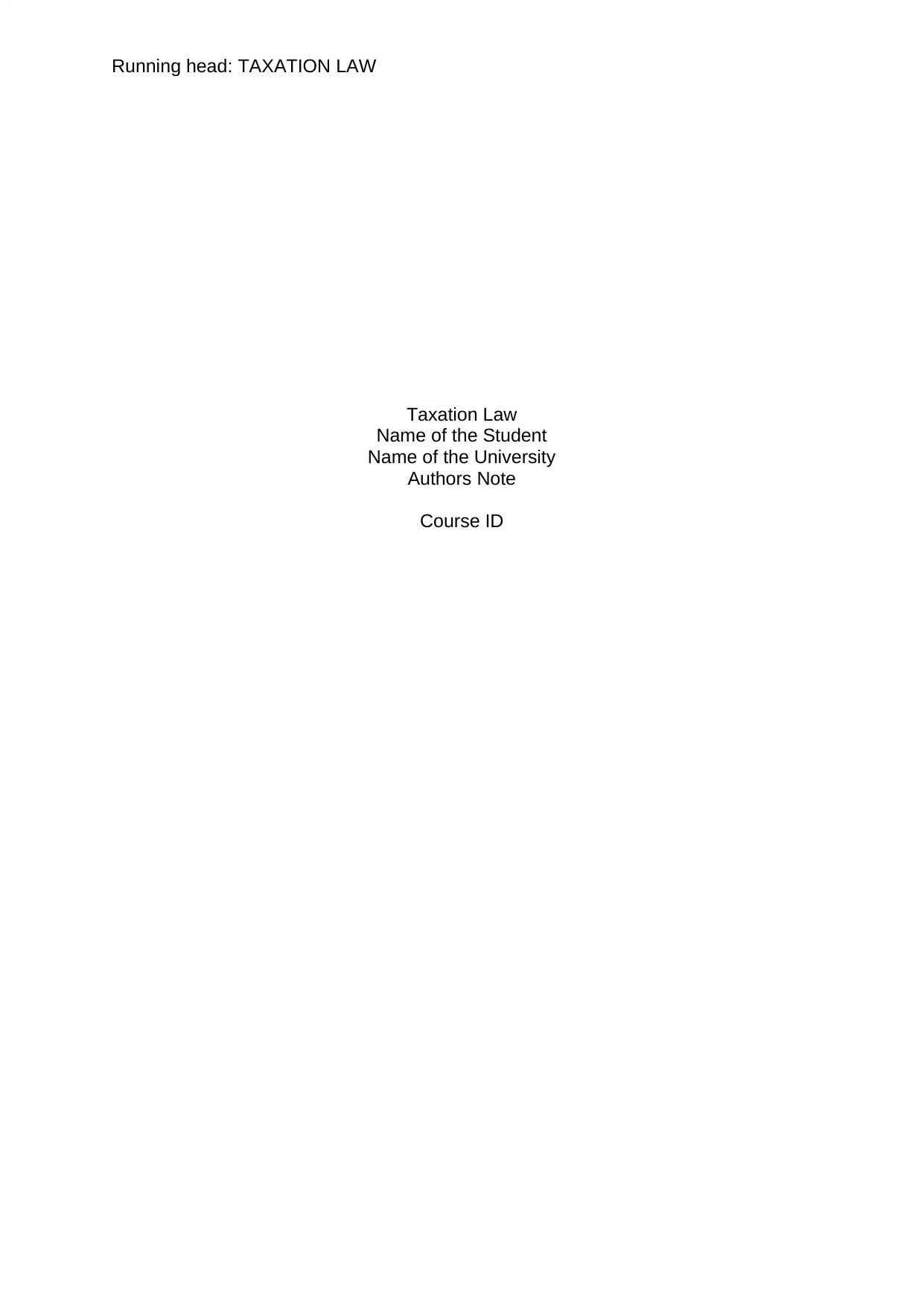
Running head: TAXATION LAW
Taxation Law
Name of the Student
Name of the University
Authors Note
Course ID
Taxation Law
Name of the Student
Name of the University
Authors Note
Course ID
Paraphrase This Document
Need a fresh take? Get an instant paraphrase of this document with our AI Paraphraser
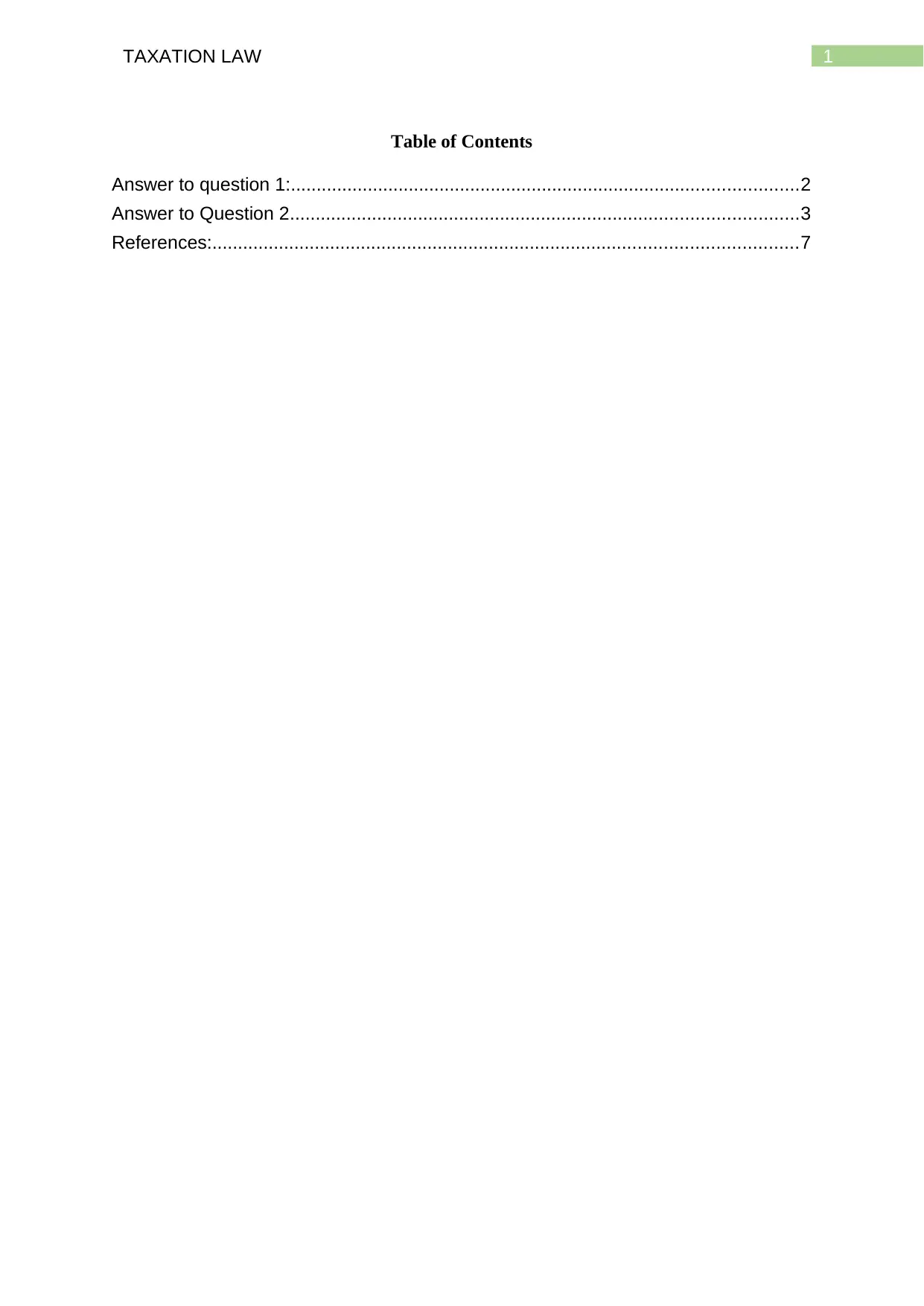
1TAXATION LAW
Table of Contents
Answer to question 1:...................................................................................................2
Answer to Question 2...................................................................................................3
References:..................................................................................................................7
Table of Contents
Answer to question 1:...................................................................................................2
Answer to Question 2...................................................................................................3
References:..................................................................................................................7
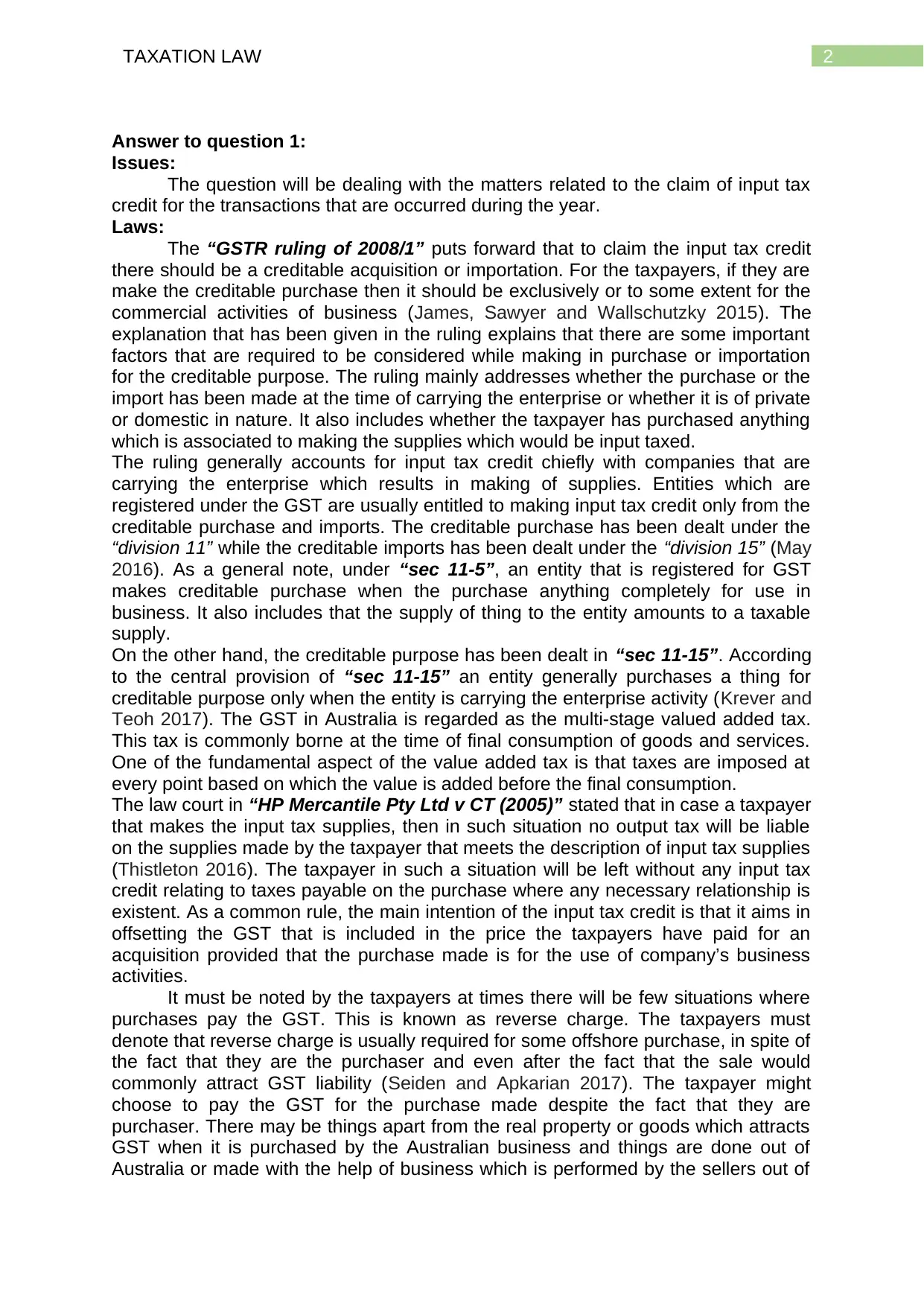
2TAXATION LAW
Answer to question 1:
Issues:
The question will be dealing with the matters related to the claim of input tax
credit for the transactions that are occurred during the year.
Laws:
The “GSTR ruling of 2008/1” puts forward that to claim the input tax credit
there should be a creditable acquisition or importation. For the taxpayers, if they are
make the creditable purchase then it should be exclusively or to some extent for the
commercial activities of business (James, Sawyer and Wallschutzky 2015). The
explanation that has been given in the ruling explains that there are some important
factors that are required to be considered while making in purchase or importation
for the creditable purpose. The ruling mainly addresses whether the purchase or the
import has been made at the time of carrying the enterprise or whether it is of private
or domestic in nature. It also includes whether the taxpayer has purchased anything
which is associated to making the supplies which would be input taxed.
The ruling generally accounts for input tax credit chiefly with companies that are
carrying the enterprise which results in making of supplies. Entities which are
registered under the GST are usually entitled to making input tax credit only from the
creditable purchase and imports. The creditable purchase has been dealt under the
“division 11” while the creditable imports has been dealt under the “division 15” (May
2016). As a general note, under “sec 11-5”, an entity that is registered for GST
makes creditable purchase when the purchase anything completely for use in
business. It also includes that the supply of thing to the entity amounts to a taxable
supply.
On the other hand, the creditable purpose has been dealt in “sec 11-15”. According
to the central provision of “sec 11-15” an entity generally purchases a thing for
creditable purpose only when the entity is carrying the enterprise activity (Krever and
Teoh 2017). The GST in Australia is regarded as the multi-stage valued added tax.
This tax is commonly borne at the time of final consumption of goods and services.
One of the fundamental aspect of the value added tax is that taxes are imposed at
every point based on which the value is added before the final consumption.
The law court in “HP Mercantile Pty Ltd v CT (2005)” stated that in case a taxpayer
that makes the input tax supplies, then in such situation no output tax will be liable
on the supplies made by the taxpayer that meets the description of input tax supplies
(Thistleton 2016). The taxpayer in such a situation will be left without any input tax
credit relating to taxes payable on the purchase where any necessary relationship is
existent. As a common rule, the main intention of the input tax credit is that it aims in
offsetting the GST that is included in the price the taxpayers have paid for an
acquisition provided that the purchase made is for the use of company’s business
activities.
It must be noted by the taxpayers at times there will be few situations where
purchases pay the GST. This is known as reverse charge. The taxpayers must
denote that reverse charge is usually required for some offshore purchase, in spite of
the fact that they are the purchaser and even after the fact that the sale would
commonly attract GST liability (Seiden and Apkarian 2017). The taxpayer might
choose to pay the GST for the purchase made despite the fact that they are
purchaser. There may be things apart from the real property or goods which attracts
GST when it is purchased by the Australian business and things are done out of
Australia or made with the help of business which is performed by the sellers out of
Answer to question 1:
Issues:
The question will be dealing with the matters related to the claim of input tax
credit for the transactions that are occurred during the year.
Laws:
The “GSTR ruling of 2008/1” puts forward that to claim the input tax credit
there should be a creditable acquisition or importation. For the taxpayers, if they are
make the creditable purchase then it should be exclusively or to some extent for the
commercial activities of business (James, Sawyer and Wallschutzky 2015). The
explanation that has been given in the ruling explains that there are some important
factors that are required to be considered while making in purchase or importation
for the creditable purpose. The ruling mainly addresses whether the purchase or the
import has been made at the time of carrying the enterprise or whether it is of private
or domestic in nature. It also includes whether the taxpayer has purchased anything
which is associated to making the supplies which would be input taxed.
The ruling generally accounts for input tax credit chiefly with companies that are
carrying the enterprise which results in making of supplies. Entities which are
registered under the GST are usually entitled to making input tax credit only from the
creditable purchase and imports. The creditable purchase has been dealt under the
“division 11” while the creditable imports has been dealt under the “division 15” (May
2016). As a general note, under “sec 11-5”, an entity that is registered for GST
makes creditable purchase when the purchase anything completely for use in
business. It also includes that the supply of thing to the entity amounts to a taxable
supply.
On the other hand, the creditable purpose has been dealt in “sec 11-15”. According
to the central provision of “sec 11-15” an entity generally purchases a thing for
creditable purpose only when the entity is carrying the enterprise activity (Krever and
Teoh 2017). The GST in Australia is regarded as the multi-stage valued added tax.
This tax is commonly borne at the time of final consumption of goods and services.
One of the fundamental aspect of the value added tax is that taxes are imposed at
every point based on which the value is added before the final consumption.
The law court in “HP Mercantile Pty Ltd v CT (2005)” stated that in case a taxpayer
that makes the input tax supplies, then in such situation no output tax will be liable
on the supplies made by the taxpayer that meets the description of input tax supplies
(Thistleton 2016). The taxpayer in such a situation will be left without any input tax
credit relating to taxes payable on the purchase where any necessary relationship is
existent. As a common rule, the main intention of the input tax credit is that it aims in
offsetting the GST that is included in the price the taxpayers have paid for an
acquisition provided that the purchase made is for the use of company’s business
activities.
It must be noted by the taxpayers at times there will be few situations where
purchases pay the GST. This is known as reverse charge. The taxpayers must
denote that reverse charge is usually required for some offshore purchase, in spite of
the fact that they are the purchaser and even after the fact that the sale would
commonly attract GST liability (Seiden and Apkarian 2017). The taxpayer might
choose to pay the GST for the purchase made despite the fact that they are
purchaser. There may be things apart from the real property or goods which attracts
GST when it is purchased by the Australian business and things are done out of
Australia or made with the help of business which is performed by the sellers out of
⊘ This is a preview!⊘
Do you want full access?
Subscribe today to unlock all pages.

Trusted by 1+ million students worldwide
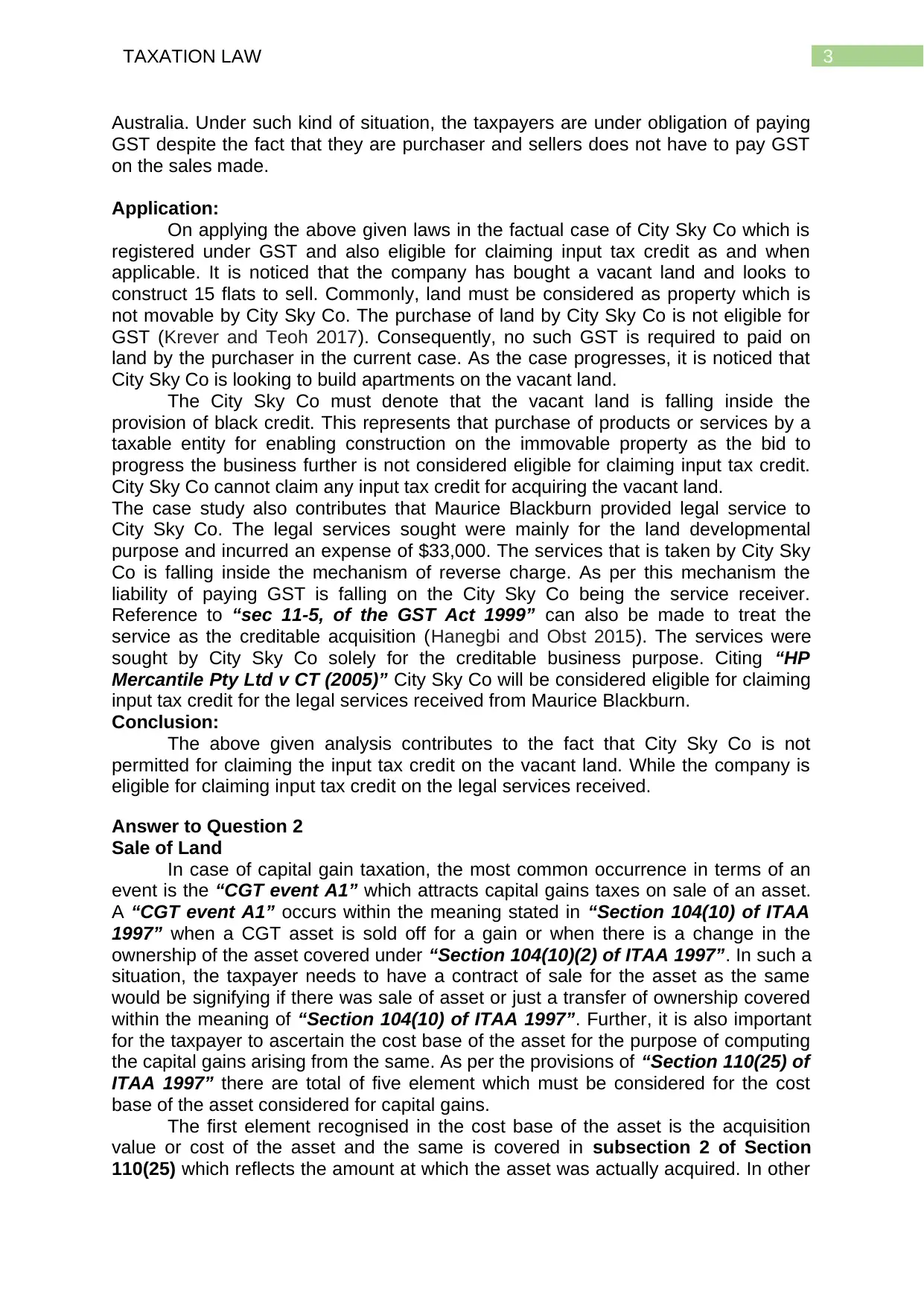
3TAXATION LAW
Australia. Under such kind of situation, the taxpayers are under obligation of paying
GST despite the fact that they are purchaser and sellers does not have to pay GST
on the sales made.
Application:
On applying the above given laws in the factual case of City Sky Co which is
registered under GST and also eligible for claiming input tax credit as and when
applicable. It is noticed that the company has bought a vacant land and looks to
construct 15 flats to sell. Commonly, land must be considered as property which is
not movable by City Sky Co. The purchase of land by City Sky Co is not eligible for
GST (Krever and Teoh 2017). Consequently, no such GST is required to paid on
land by the purchaser in the current case. As the case progresses, it is noticed that
City Sky Co is looking to build apartments on the vacant land.
The City Sky Co must denote that the vacant land is falling inside the
provision of black credit. This represents that purchase of products or services by a
taxable entity for enabling construction on the immovable property as the bid to
progress the business further is not considered eligible for claiming input tax credit.
City Sky Co cannot claim any input tax credit for acquiring the vacant land.
The case study also contributes that Maurice Blackburn provided legal service to
City Sky Co. The legal services sought were mainly for the land developmental
purpose and incurred an expense of $33,000. The services that is taken by City Sky
Co is falling inside the mechanism of reverse charge. As per this mechanism the
liability of paying GST is falling on the City Sky Co being the service receiver.
Reference to “sec 11-5, of the GST Act 1999” can also be made to treat the
service as the creditable acquisition (Hanegbi and Obst 2015). The services were
sought by City Sky Co solely for the creditable business purpose. Citing “HP
Mercantile Pty Ltd v CT (2005)” City Sky Co will be considered eligible for claiming
input tax credit for the legal services received from Maurice Blackburn.
Conclusion:
The above given analysis contributes to the fact that City Sky Co is not
permitted for claiming the input tax credit on the vacant land. While the company is
eligible for claiming input tax credit on the legal services received.
Answer to Question 2
Sale of Land
In case of capital gain taxation, the most common occurrence in terms of an
event is the “CGT event A1” which attracts capital gains taxes on sale of an asset.
A “CGT event A1” occurs within the meaning stated in “Section 104(10) of ITAA
1997” when a CGT asset is sold off for a gain or when there is a change in the
ownership of the asset covered under “Section 104(10)(2) of ITAA 1997”. In such a
situation, the taxpayer needs to have a contract of sale for the asset as the same
would be signifying if there was sale of asset or just a transfer of ownership covered
within the meaning of “Section 104(10) of ITAA 1997”. Further, it is also important
for the taxpayer to ascertain the cost base of the asset for the purpose of computing
the capital gains arising from the same. As per the provisions of “Section 110(25) of
ITAA 1997” there are total of five element which must be considered for the cost
base of the asset considered for capital gains.
The first element recognised in the cost base of the asset is the acquisition
value or cost of the asset and the same is covered in subsection 2 of Section
110(25) which reflects the amount at which the asset was actually acquired. In other
Australia. Under such kind of situation, the taxpayers are under obligation of paying
GST despite the fact that they are purchaser and sellers does not have to pay GST
on the sales made.
Application:
On applying the above given laws in the factual case of City Sky Co which is
registered under GST and also eligible for claiming input tax credit as and when
applicable. It is noticed that the company has bought a vacant land and looks to
construct 15 flats to sell. Commonly, land must be considered as property which is
not movable by City Sky Co. The purchase of land by City Sky Co is not eligible for
GST (Krever and Teoh 2017). Consequently, no such GST is required to paid on
land by the purchaser in the current case. As the case progresses, it is noticed that
City Sky Co is looking to build apartments on the vacant land.
The City Sky Co must denote that the vacant land is falling inside the
provision of black credit. This represents that purchase of products or services by a
taxable entity for enabling construction on the immovable property as the bid to
progress the business further is not considered eligible for claiming input tax credit.
City Sky Co cannot claim any input tax credit for acquiring the vacant land.
The case study also contributes that Maurice Blackburn provided legal service to
City Sky Co. The legal services sought were mainly for the land developmental
purpose and incurred an expense of $33,000. The services that is taken by City Sky
Co is falling inside the mechanism of reverse charge. As per this mechanism the
liability of paying GST is falling on the City Sky Co being the service receiver.
Reference to “sec 11-5, of the GST Act 1999” can also be made to treat the
service as the creditable acquisition (Hanegbi and Obst 2015). The services were
sought by City Sky Co solely for the creditable business purpose. Citing “HP
Mercantile Pty Ltd v CT (2005)” City Sky Co will be considered eligible for claiming
input tax credit for the legal services received from Maurice Blackburn.
Conclusion:
The above given analysis contributes to the fact that City Sky Co is not
permitted for claiming the input tax credit on the vacant land. While the company is
eligible for claiming input tax credit on the legal services received.
Answer to Question 2
Sale of Land
In case of capital gain taxation, the most common occurrence in terms of an
event is the “CGT event A1” which attracts capital gains taxes on sale of an asset.
A “CGT event A1” occurs within the meaning stated in “Section 104(10) of ITAA
1997” when a CGT asset is sold off for a gain or when there is a change in the
ownership of the asset covered under “Section 104(10)(2) of ITAA 1997”. In such a
situation, the taxpayer needs to have a contract of sale for the asset as the same
would be signifying if there was sale of asset or just a transfer of ownership covered
within the meaning of “Section 104(10) of ITAA 1997”. Further, it is also important
for the taxpayer to ascertain the cost base of the asset for the purpose of computing
the capital gains arising from the same. As per the provisions of “Section 110(25) of
ITAA 1997” there are total of five element which must be considered for the cost
base of the asset considered for capital gains.
The first element recognised in the cost base of the asset is the acquisition
value or cost of the asset and the same is covered in subsection 2 of Section
110(25) which reflects the amount at which the asset was actually acquired. In other
Paraphrase This Document
Need a fresh take? Get an instant paraphrase of this document with our AI Paraphraser
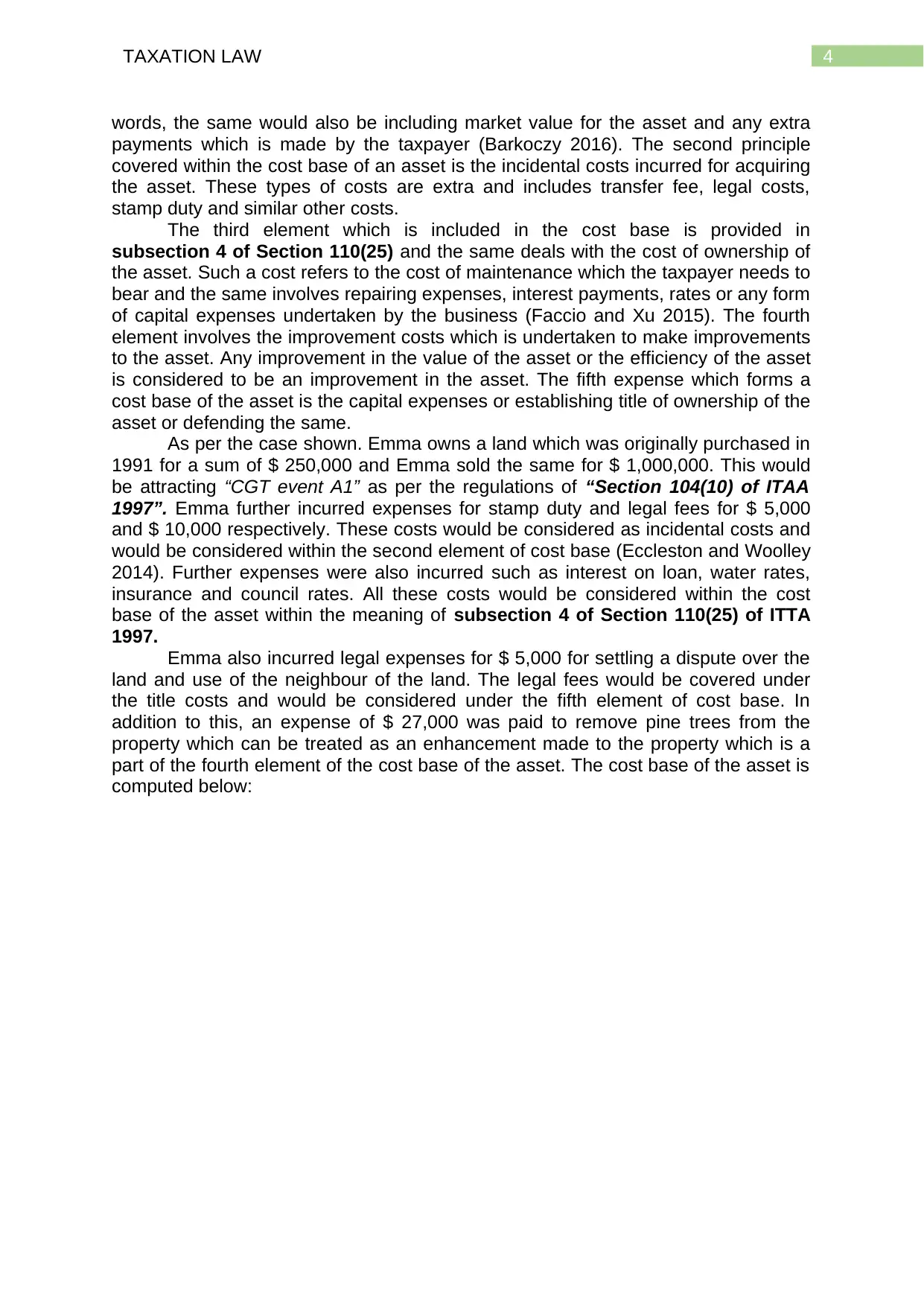
4TAXATION LAW
words, the same would also be including market value for the asset and any extra
payments which is made by the taxpayer (Barkoczy 2016). The second principle
covered within the cost base of an asset is the incidental costs incurred for acquiring
the asset. These types of costs are extra and includes transfer fee, legal costs,
stamp duty and similar other costs.
The third element which is included in the cost base is provided in
subsection 4 of Section 110(25) and the same deals with the cost of ownership of
the asset. Such a cost refers to the cost of maintenance which the taxpayer needs to
bear and the same involves repairing expenses, interest payments, rates or any form
of capital expenses undertaken by the business (Faccio and Xu 2015). The fourth
element involves the improvement costs which is undertaken to make improvements
to the asset. Any improvement in the value of the asset or the efficiency of the asset
is considered to be an improvement in the asset. The fifth expense which forms a
cost base of the asset is the capital expenses or establishing title of ownership of the
asset or defending the same.
As per the case shown. Emma owns a land which was originally purchased in
1991 for a sum of $ 250,000 and Emma sold the same for $ 1,000,000. This would
be attracting “CGT event A1” as per the regulations of “Section 104(10) of ITAA
1997”. Emma further incurred expenses for stamp duty and legal fees for $ 5,000
and $ 10,000 respectively. These costs would be considered as incidental costs and
would be considered within the second element of cost base (Eccleston and Woolley
2014). Further expenses were also incurred such as interest on loan, water rates,
insurance and council rates. All these costs would be considered within the cost
base of the asset within the meaning of subsection 4 of Section 110(25) of ITTA
1997.
Emma also incurred legal expenses for $ 5,000 for settling a dispute over the
land and use of the neighbour of the land. The legal fees would be covered under
the title costs and would be considered under the fifth element of cost base. In
addition to this, an expense of $ 27,000 was paid to remove pine trees from the
property which can be treated as an enhancement made to the property which is a
part of the fourth element of the cost base of the asset. The cost base of the asset is
computed below:
words, the same would also be including market value for the asset and any extra
payments which is made by the taxpayer (Barkoczy 2016). The second principle
covered within the cost base of an asset is the incidental costs incurred for acquiring
the asset. These types of costs are extra and includes transfer fee, legal costs,
stamp duty and similar other costs.
The third element which is included in the cost base is provided in
subsection 4 of Section 110(25) and the same deals with the cost of ownership of
the asset. Such a cost refers to the cost of maintenance which the taxpayer needs to
bear and the same involves repairing expenses, interest payments, rates or any form
of capital expenses undertaken by the business (Faccio and Xu 2015). The fourth
element involves the improvement costs which is undertaken to make improvements
to the asset. Any improvement in the value of the asset or the efficiency of the asset
is considered to be an improvement in the asset. The fifth expense which forms a
cost base of the asset is the capital expenses or establishing title of ownership of the
asset or defending the same.
As per the case shown. Emma owns a land which was originally purchased in
1991 for a sum of $ 250,000 and Emma sold the same for $ 1,000,000. This would
be attracting “CGT event A1” as per the regulations of “Section 104(10) of ITAA
1997”. Emma further incurred expenses for stamp duty and legal fees for $ 5,000
and $ 10,000 respectively. These costs would be considered as incidental costs and
would be considered within the second element of cost base (Eccleston and Woolley
2014). Further expenses were also incurred such as interest on loan, water rates,
insurance and council rates. All these costs would be considered within the cost
base of the asset within the meaning of subsection 4 of Section 110(25) of ITTA
1997.
Emma also incurred legal expenses for $ 5,000 for settling a dispute over the
land and use of the neighbour of the land. The legal fees would be covered under
the title costs and would be considered under the fifth element of cost base. In
addition to this, an expense of $ 27,000 was paid to remove pine trees from the
property which can be treated as an enhancement made to the property which is a
part of the fourth element of the cost base of the asset. The cost base of the asset is
computed below:
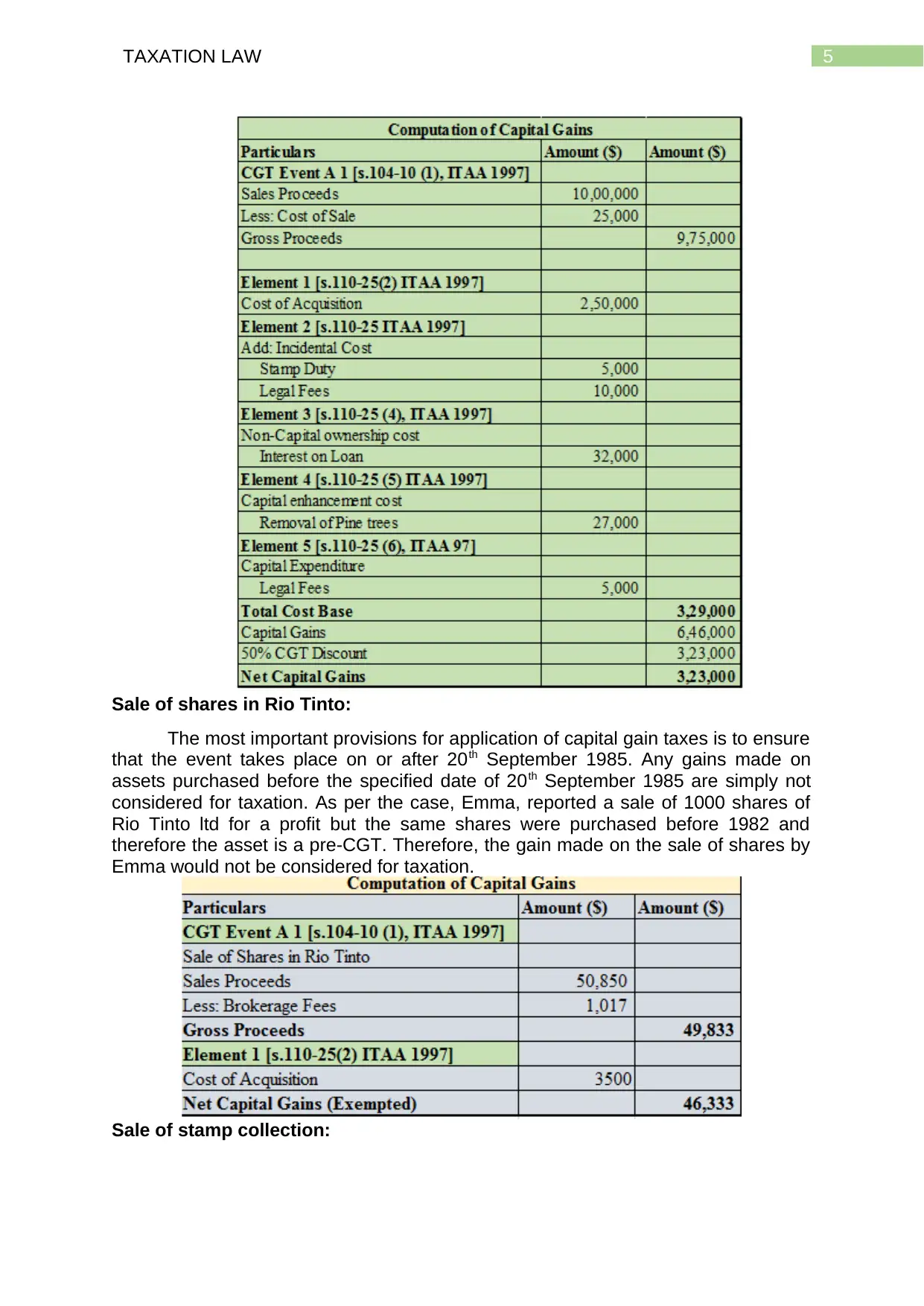
5TAXATION LAW
Sale of shares in Rio Tinto:
The most important provisions for application of capital gain taxes is to ensure
that the event takes place on or after 20th September 1985. Any gains made on
assets purchased before the specified date of 20th September 1985 are simply not
considered for taxation. As per the case, Emma, reported a sale of 1000 shares of
Rio Tinto ltd for a profit but the same shares were purchased before 1982 and
therefore the asset is a pre-CGT. Therefore, the gain made on the sale of shares by
Emma would not be considered for taxation.
Sale of stamp collection:
Sale of shares in Rio Tinto:
The most important provisions for application of capital gain taxes is to ensure
that the event takes place on or after 20th September 1985. Any gains made on
assets purchased before the specified date of 20th September 1985 are simply not
considered for taxation. As per the case, Emma, reported a sale of 1000 shares of
Rio Tinto ltd for a profit but the same shares were purchased before 1982 and
therefore the asset is a pre-CGT. Therefore, the gain made on the sale of shares by
Emma would not be considered for taxation.
Sale of stamp collection:
⊘ This is a preview!⊘
Do you want full access?
Subscribe today to unlock all pages.

Trusted by 1+ million students worldwide
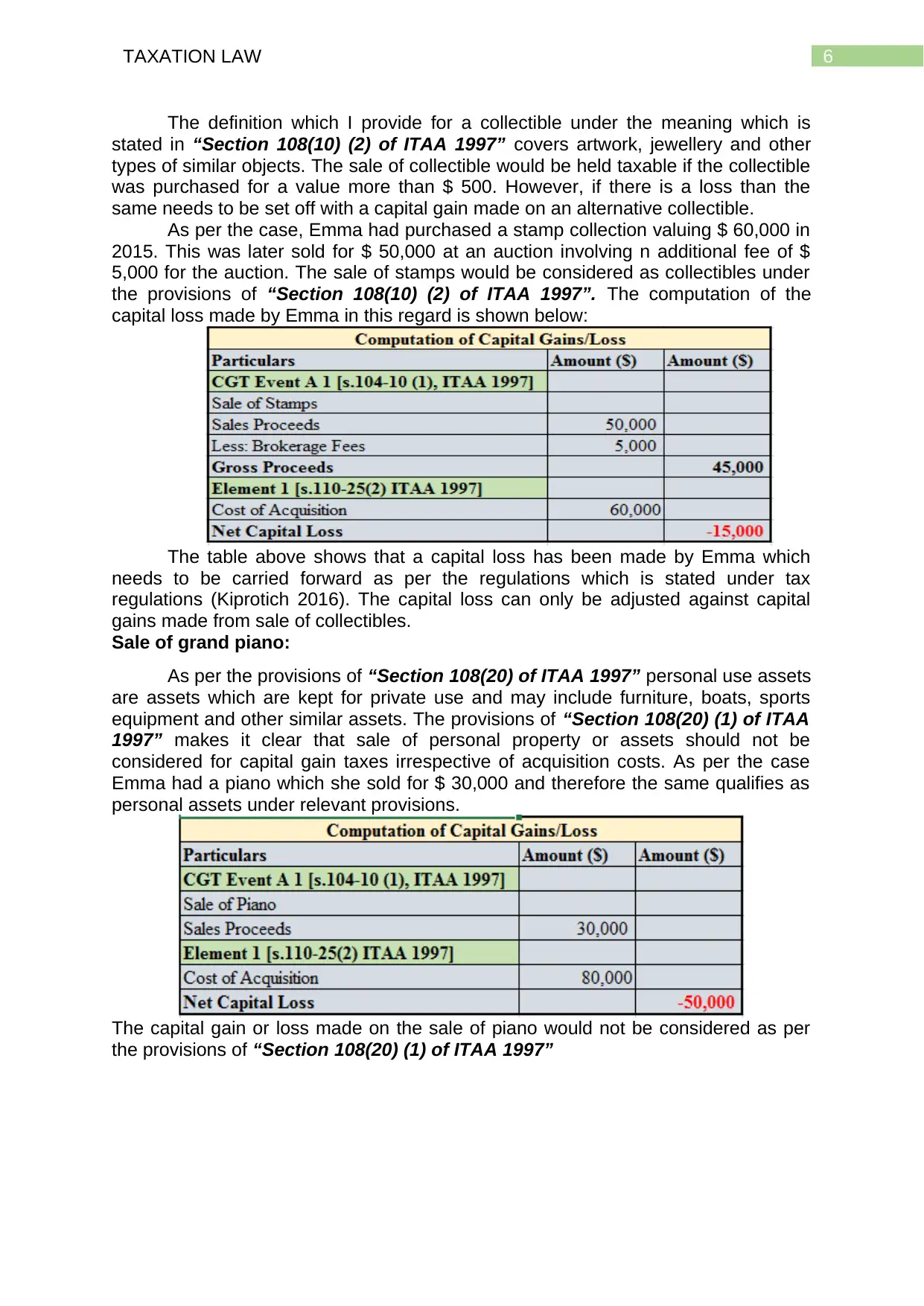
6TAXATION LAW
The definition which I provide for a collectible under the meaning which is
stated in “Section 108(10) (2) of ITAA 1997” covers artwork, jewellery and other
types of similar objects. The sale of collectible would be held taxable if the collectible
was purchased for a value more than $ 500. However, if there is a loss than the
same needs to be set off with a capital gain made on an alternative collectible.
As per the case, Emma had purchased a stamp collection valuing $ 60,000 in
2015. This was later sold for $ 50,000 at an auction involving n additional fee of $
5,000 for the auction. The sale of stamps would be considered as collectibles under
the provisions of “Section 108(10) (2) of ITAA 1997”. The computation of the
capital loss made by Emma in this regard is shown below:
The table above shows that a capital loss has been made by Emma which
needs to be carried forward as per the regulations which is stated under tax
regulations (Kiprotich 2016). The capital loss can only be adjusted against capital
gains made from sale of collectibles.
Sale of grand piano:
As per the provisions of “Section 108(20) of ITAA 1997” personal use assets
are assets which are kept for private use and may include furniture, boats, sports
equipment and other similar assets. The provisions of “Section 108(20) (1) of ITAA
1997” makes it clear that sale of personal property or assets should not be
considered for capital gain taxes irrespective of acquisition costs. As per the case
Emma had a piano which she sold for $ 30,000 and therefore the same qualifies as
personal assets under relevant provisions.
The capital gain or loss made on the sale of piano would not be considered as per
the provisions of “Section 108(20) (1) of ITAA 1997”
The definition which I provide for a collectible under the meaning which is
stated in “Section 108(10) (2) of ITAA 1997” covers artwork, jewellery and other
types of similar objects. The sale of collectible would be held taxable if the collectible
was purchased for a value more than $ 500. However, if there is a loss than the
same needs to be set off with a capital gain made on an alternative collectible.
As per the case, Emma had purchased a stamp collection valuing $ 60,000 in
2015. This was later sold for $ 50,000 at an auction involving n additional fee of $
5,000 for the auction. The sale of stamps would be considered as collectibles under
the provisions of “Section 108(10) (2) of ITAA 1997”. The computation of the
capital loss made by Emma in this regard is shown below:
The table above shows that a capital loss has been made by Emma which
needs to be carried forward as per the regulations which is stated under tax
regulations (Kiprotich 2016). The capital loss can only be adjusted against capital
gains made from sale of collectibles.
Sale of grand piano:
As per the provisions of “Section 108(20) of ITAA 1997” personal use assets
are assets which are kept for private use and may include furniture, boats, sports
equipment and other similar assets. The provisions of “Section 108(20) (1) of ITAA
1997” makes it clear that sale of personal property or assets should not be
considered for capital gain taxes irrespective of acquisition costs. As per the case
Emma had a piano which she sold for $ 30,000 and therefore the same qualifies as
personal assets under relevant provisions.
The capital gain or loss made on the sale of piano would not be considered as per
the provisions of “Section 108(20) (1) of ITAA 1997”
Paraphrase This Document
Need a fresh take? Get an instant paraphrase of this document with our AI Paraphraser
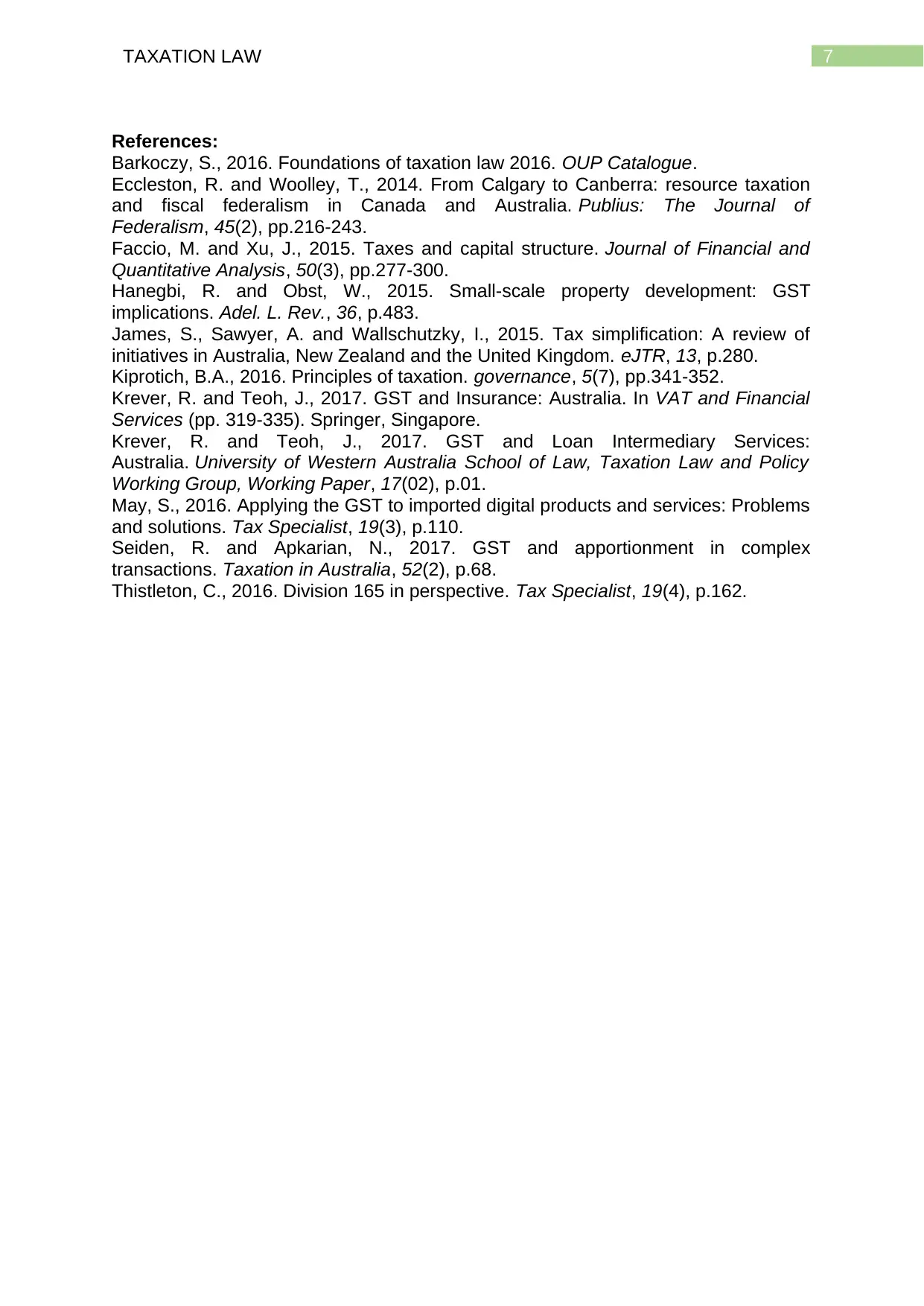
7TAXATION LAW
References:
Barkoczy, S., 2016. Foundations of taxation law 2016. OUP Catalogue.
Eccleston, R. and Woolley, T., 2014. From Calgary to Canberra: resource taxation
and fiscal federalism in Canada and Australia. Publius: The Journal of
Federalism, 45(2), pp.216-243.
Faccio, M. and Xu, J., 2015. Taxes and capital structure. Journal of Financial and
Quantitative Analysis, 50(3), pp.277-300.
Hanegbi, R. and Obst, W., 2015. Small-scale property development: GST
implications. Adel. L. Rev., 36, p.483.
James, S., Sawyer, A. and Wallschutzky, I., 2015. Tax simplification: A review of
initiatives in Australia, New Zealand and the United Kingdom. eJTR, 13, p.280.
Kiprotich, B.A., 2016. Principles of taxation. governance, 5(7), pp.341-352.
Krever, R. and Teoh, J., 2017. GST and Insurance: Australia. In VAT and Financial
Services (pp. 319-335). Springer, Singapore.
Krever, R. and Teoh, J., 2017. GST and Loan Intermediary Services:
Australia. University of Western Australia School of Law, Taxation Law and Policy
Working Group, Working Paper, 17(02), p.01.
May, S., 2016. Applying the GST to imported digital products and services: Problems
and solutions. Tax Specialist, 19(3), p.110.
Seiden, R. and Apkarian, N., 2017. GST and apportionment in complex
transactions. Taxation in Australia, 52(2), p.68.
Thistleton, C., 2016. Division 165 in perspective. Tax Specialist, 19(4), p.162.
References:
Barkoczy, S., 2016. Foundations of taxation law 2016. OUP Catalogue.
Eccleston, R. and Woolley, T., 2014. From Calgary to Canberra: resource taxation
and fiscal federalism in Canada and Australia. Publius: The Journal of
Federalism, 45(2), pp.216-243.
Faccio, M. and Xu, J., 2015. Taxes and capital structure. Journal of Financial and
Quantitative Analysis, 50(3), pp.277-300.
Hanegbi, R. and Obst, W., 2015. Small-scale property development: GST
implications. Adel. L. Rev., 36, p.483.
James, S., Sawyer, A. and Wallschutzky, I., 2015. Tax simplification: A review of
initiatives in Australia, New Zealand and the United Kingdom. eJTR, 13, p.280.
Kiprotich, B.A., 2016. Principles of taxation. governance, 5(7), pp.341-352.
Krever, R. and Teoh, J., 2017. GST and Insurance: Australia. In VAT and Financial
Services (pp. 319-335). Springer, Singapore.
Krever, R. and Teoh, J., 2017. GST and Loan Intermediary Services:
Australia. University of Western Australia School of Law, Taxation Law and Policy
Working Group, Working Paper, 17(02), p.01.
May, S., 2016. Applying the GST to imported digital products and services: Problems
and solutions. Tax Specialist, 19(3), p.110.
Seiden, R. and Apkarian, N., 2017. GST and apportionment in complex
transactions. Taxation in Australia, 52(2), p.68.
Thistleton, C., 2016. Division 165 in perspective. Tax Specialist, 19(4), p.162.
1 out of 8
Related Documents
Your All-in-One AI-Powered Toolkit for Academic Success.
+13062052269
info@desklib.com
Available 24*7 on WhatsApp / Email
![[object Object]](/_next/static/media/star-bottom.7253800d.svg)
Unlock your academic potential
Copyright © 2020–2025 A2Z Services. All Rights Reserved. Developed and managed by ZUCOL.




